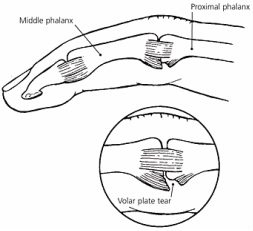| Finger injuries are common amongst the sporting community and their severity is just as commonly underestimated. Whilst the large majority of finger injuries are minor and apart from rest and ice require no further management, there are some that are considered serious, even to the point where surgical intervention may be required if not managed quickly.
After an acute injury there are a number of structures within your finger that require examination to assess the degree and type of injury sustained. And in some cases early immobilization is your best chance of making a full recovery and regaining full function of your finger.
Mild collateral ligament sprains are the most common finger injury and heal quickly with little to no intervention. However injuries of a similar nature and force can cause enough damage to the collateral ligaments where a partial tear may have occurred and splinting or surgery is required to allow adequate healing. Most collateral ligament injuries recover with taping and physiotherapy to restore range of motion.
Mallet finger is one of the most common tendon injuries and is where the end of the finger is unable to straighten fully. This is commonly seen when a ball strikes the end of the finger. Mallet finger occurs when the tendon attaching to the tip of the finger has been completely torn and requires imaging to confirm. Treatment includes splinting for a period of 6-8 weeks depending on severity, with regular monitoring to allow adequate healing. Again, x-rays should be taken to exclude the possibility of a fracture, if an antra-articular fracture exists, surgery may be warranted.
Boutonniere Deformity is a less common finger injury, left untreated this condition can become worse. It can be caused by blunt trauma to the finger or a ball hitting the tip of the finger. It results when the tendon across the back of the knuckle joint tears or avulses a bone fragment and causes the end of the finger to straighten and the middle of the finger to bend. The condition requires a specific type of splint for 4-6 weeks to allow the tendon to heal. Hand therapy to restore range of motion and strength in then needed to return the hand to full functioning.
Disruption of the volar plate is another common finger injury. The volar plate is a thickening of the joint capsule on the underneath side of the knuckle. Damage of the volar plate commonly occurs with hyper-extension of the finger and can result in the finger dislocating and the joint becoming unstable. X-rays should be taken to exclude an avulsion fracture. Treatment involves splinting to immobilise the joint for 2-4 weeks to allow healing of the ligamentous plate.
In the case of a fracture to one of the metacarpals or phalanges once they have been imaged to confirm the diagnosis most require a period of immobilization. The position, length of time and area to be immobilized is dependent on the type of fracture and where it has occurred. In some cases fractures of the hand and finger may not present with large amounts of swelling or pain which is why proper assessment is important after an acute finger injury.
There are also types of fractures that require surgical intervention regardless of whether they are detected early or not. In the case of impact down the line of the thumb i.e. jarring your thumb, a Bennett’s fracture (fracture dislocation of the first metacarpal) may have been sustained which requires management from a hand surgeon. Dislocation is not always obvious within the smaller joints particularly in areas where swelling has occurred, a swollen or misshapen finger is one that needs to be assessed as soon as possible.
The importance of early assessment and management of acute finger injuries cannot be stressed enough. A physiotherapist’s role in the assessment phase is to examine the type and extent of the injury and whether or not it requires imaging to confirm a diagnosis. A physiotherapist can then provide a patient with a splint or brace to encourage healing of the damaged tissue. Finally in the process of regaining function of the injured finger a physiotherapist can provide you with exercises to help improve your range of motion and strengthen the muscles involved.
|
